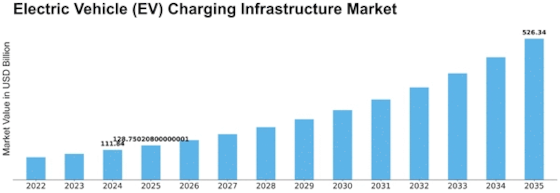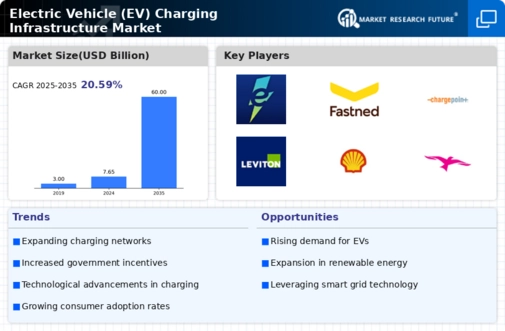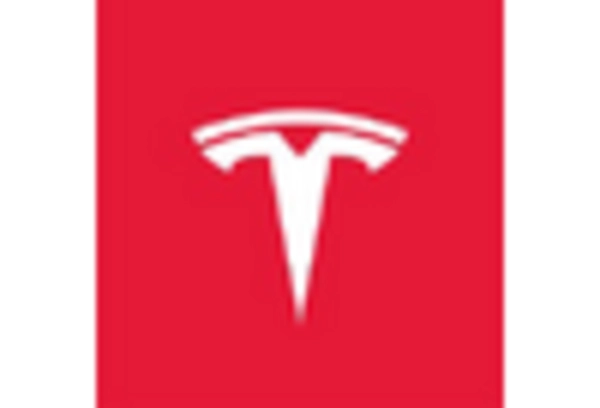-
EXECUTIVE SUMMARY
-
Market Overview
-
Key Findings
-
Market Segmentation
-
Competitive Landscape
-
Challenges and Opportunities
-
Future Outlook
-
MARKET INTRODUCTION
-
Definition
-
Scope of the study
- Research Objective
- Assumption
- Limitations
-
RESEARCH METHODOLOGY
-
Overview
-
Data Mining
-
Secondary Research
-
Primary Research
- Primary Interviews and Information Gathering Process
- Breakdown of Primary Respondents
-
Forecasting Model
-
Market Size Estimation
- Bottom-Up Approach
- Top-Down Approach
-
Data Triangulation
-
Validation
-
MARKET DYNAMICS
-
Overview
-
Drivers
-
Restraints
-
Opportunities
-
MARKET FACTOR ANALYSIS
-
Value chain Analysis
-
Porter's Five Forces Analysis
- Bargaining Power of Suppliers
- Bargaining Power of Buyers
- Threat of New Entrants
- Threat of Substitutes
- Intensity of Rivalry
-
COVID-19 Impact Analysis
- Market Impact Analysis
- Regional Impact
- Opportunity and Threat Analysis
-
ELECTRIC VEHICLE (EV) CHARGING INFRASTRUCTURE MARKET, BY CHARGER TYPE (USD BILLION)
-
Level 1 Charger
-
Level 2 Charger
-
DC Fast Charger
-
Wireless Charger
-
ELECTRIC VEHICLE (EV) CHARGING INFRASTRUCTURE MARKET, BY CHARGING LOCATION (USD BILLION)
-
Home Charging
-
Public Charging Stations
-
Workplace Charging
-
Destination Charging
-
ELECTRIC VEHICLE (EV) CHARGING INFRASTRUCTURE MARKET, BY CONNECTOR TYPE (USD BILLION)
-
Type 1 Connector
-
Type 2 Connector
-
CCS Connector
-
CHAdeMO Connector
-
ELECTRIC VEHICLE (EV) CHARGING INFRASTRUCTURE MARKET, BY END USER (USD BILLION)
-
Residential
-
Commercial
-
Fleet Operators
-
Government
-
ELECTRIC VEHICLE (EV) CHARGING INFRASTRUCTURE MARKET, BY REGIONAL (USD BILLION)
-
North America
- US
- Canada
-
Europe
- Germany
- UK
- France
- Russia
- Italy
- Spain
- Rest of Europe
-
APAC
- China
- India
- Japan
- South Korea
- Malaysia
- Thailand
- Indonesia
- Rest of APAC
-
South America
- Brazil
- Mexico
- Argentina
- Rest of South America
-
MEA
- GCC Countries
- South Africa
- Rest of MEA
-
COMPETITIVE LANDSCAPE
-
Overview
-
Competitive Analysis
-
Market share Analysis
-
Major Growth Strategy in the Electric Vehicle (EV) Charging Infrastructure Market
-
Competitive Benchmarking
-
Leading Players in Terms of Number of Developments in the Electric Vehicle (EV) Charging Infrastructure Market
-
Key developments and growth strategies
- New Product Launch/Service Deployment
- Merger & Acquisitions
- Joint Ventures
-
Major Players Financial Matrix
- Sales and Operating Income
- Major Players R&D Expenditure. 2023
-
COMPANY PROFILES
-
ABB
- Financial Overview
- Products Offered
- Key Developments
- SWOT Analysis
- Key Strategies
-
Fastned
- Financial Overview
- Products Offered
- Key Developments
- SWOT Analysis
- Key Strategies
-
BP
- Financial Overview
- Products Offered
- Key Developments
- SWOT Analysis
- Key Strategies
-
EVBox
- Financial Overview
- Products Offered
- Key Developments
- SWOT Analysis
- Key Strategies
-
Shell
- Financial Overview
- Products Offered
- Key Developments
- SWOT Analysis
- Key Strategies
-
Ionity
- Financial Overview
- Products Offered
- Key Developments
- SWOT Analysis
- Key Strategies
-
Tesla
- Financial Overview
- Products Offered
- Key Developments
- SWOT Analysis
- Key Strategies
-
ChargePoint
- Financial Overview
- Products Offered
- Key Developments
- SWOT Analysis
- Key Strategies
-
Greenlots
- Financial Overview
- Products Offered
- Key Developments
- SWOT Analysis
- Key Strategies
-
Blink Charging
- Financial Overview
- Products Offered
- Key Developments
- SWOT Analysis
- Key Strategies
-
Electrify America
- Financial Overview
- Products Offered
- Key Developments
- SWOT Analysis
- Key Strategies
-
Leviton
- Financial Overview
- Products Offered
- Key Developments
- SWOT Analysis
- Key Strategies
-
Tronity
- Financial Overview
- Products Offered
- Key Developments
- SWOT Analysis
- Key Strategies
-
Enel X
- Financial Overview
- Products Offered
- Key Developments
- SWOT Analysis
- Key Strategies
-
Siemens
- Financial Overview
- Products Offered
- Key Developments
- SWOT Analysis
- Key Strategies
-
APPENDIX
-
References
-
Related Reports
-
LIST OF TABLES
-
LIST OF ASSUMPTIONS
-
NORTH AMERICA ELECTRIC VEHICLE (EV) CHARGING INFRASTRUCTURE MARKET SIZE ESTIMATES & FORECAST, BY CHARGER TYPE, 2019-2035 (USD BILLIONS)
-
NORTH AMERICA ELECTRIC VEHICLE (EV) CHARGING INFRASTRUCTURE MARKET SIZE ESTIMATES & FORECAST, BY CHARGING LOCATION, 2019-2035 (USD BILLIONS)
-
NORTH AMERICA ELECTRIC VEHICLE (EV) CHARGING INFRASTRUCTURE MARKET SIZE ESTIMATES & FORECAST, BY CONNECTOR TYPE, 2019-2035 (USD BILLIONS)
-
NORTH AMERICA ELECTRIC VEHICLE (EV) CHARGING INFRASTRUCTURE MARKET SIZE ESTIMATES & FORECAST, BY END USER, 2019-2035 (USD BILLIONS)
-
NORTH AMERICA ELECTRIC VEHICLE (EV) CHARGING INFRASTRUCTURE MARKET SIZE ESTIMATES & FORECAST, BY REGIONAL, 2019-2035 (USD BILLIONS)
-
US ELECTRIC VEHICLE (EV) CHARGING INFRASTRUCTURE MARKET SIZE ESTIMATES & FORECAST, BY CHARGER TYPE, 2019-2035 (USD BILLIONS)
-
US ELECTRIC VEHICLE (EV) CHARGING INFRASTRUCTURE MARKET SIZE ESTIMATES & FORECAST, BY CHARGING LOCATION, 2019-2035 (USD BILLIONS)
-
US ELECTRIC VEHICLE (EV) CHARGING INFRASTRUCTURE MARKET SIZE ESTIMATES & FORECAST, BY CONNECTOR TYPE, 2019-2035 (USD BILLIONS)
-
US ELECTRIC VEHICLE (EV) CHARGING INFRASTRUCTURE MARKET SIZE ESTIMATES & FORECAST, BY END USER, 2019-2035 (USD BILLIONS)
-
US ELECTRIC VEHICLE (EV) CHARGING INFRASTRUCTURE MARKET SIZE ESTIMATES & FORECAST, BY REGIONAL, 2019-2035 (USD BILLIONS)
-
CANADA ELECTRIC VEHICLE (EV) CHARGING INFRASTRUCTURE MARKET SIZE ESTIMATES & FORECAST, BY CHARGER TYPE, 2019-2035 (USD BILLIONS)
-
CANADA ELECTRIC VEHICLE (EV) CHARGING INFRASTRUCTURE MARKET SIZE ESTIMATES & FORECAST, BY CHARGING LOCATION, 2019-2035 (USD BILLIONS)
-
CANADA ELECTRIC VEHICLE (EV) CHARGING INFRASTRUCTURE MARKET SIZE ESTIMATES & FORECAST, BY CONNECTOR TYPE, 2019-2035 (USD BILLIONS)
-
CANADA ELECTRIC VEHICLE (EV) CHARGING INFRASTRUCTURE MARKET SIZE ESTIMATES & FORECAST, BY END USER, 2019-2035 (USD BILLIONS)
-
CANADA ELECTRIC VEHICLE (EV) CHARGING INFRASTRUCTURE MARKET SIZE ESTIMATES & FORECAST, BY REGIONAL, 2019-2035 (USD BILLIONS)
-
EUROPE ELECTRIC VEHICLE (EV) CHARGING INFRASTRUCTURE MARKET SIZE ESTIMATES & FORECAST, BY CHARGER TYPE, 2019-2035 (USD BILLIONS)
-
EUROPE ELECTRIC VEHICLE (EV) CHARGING INFRASTRUCTURE MARKET SIZE ESTIMATES & FORECAST, BY CHARGING LOCATION, 2019-2035 (USD BILLIONS)
-
EUROPE ELECTRIC VEHICLE (EV) CHARGING INFRASTRUCTURE MARKET SIZE ESTIMATES & FORECAST, BY CONNECTOR TYPE, 2019-2035 (USD BILLIONS)
-
EUROPE ELECTRIC VEHICLE (EV) CHARGING INFRASTRUCTURE MARKET SIZE ESTIMATES & FORECAST, BY END USER, 2019-2035 (USD BILLIONS)
-
EUROPE ELECTRIC VEHICLE (EV) CHARGING INFRASTRUCTURE MARKET SIZE ESTIMATES & FORECAST, BY REGIONAL, 2019-2035 (USD BILLIONS)
-
GERMANY ELECTRIC VEHICLE (EV) CHARGING INFRASTRUCTURE MARKET SIZE ESTIMATES & FORECAST, BY CHARGER TYPE, 2019-2035 (USD BILLIONS)
-
GERMANY ELECTRIC VEHICLE (EV) CHARGING INFRASTRUCTURE MARKET SIZE ESTIMATES & FORECAST, BY CHARGING LOCATION, 2019-2035 (USD BILLIONS)
-
GERMANY ELECTRIC VEHICLE (EV) CHARGING INFRASTRUCTURE MARKET SIZE ESTIMATES & FORECAST, BY CONNECTOR TYPE, 2019-2035 (USD BILLIONS)
-
GERMANY ELECTRIC VEHICLE (EV) CHARGING INFRASTRUCTURE MARKET SIZE ESTIMATES & FORECAST, BY END USER, 2019-2035 (USD BILLIONS)
-
GERMANY ELECTRIC VEHICLE (EV) CHARGING INFRASTRUCTURE MARKET SIZE ESTIMATES & FORECAST, BY REGIONAL, 2019-2035 (USD BILLIONS)
-
UK ELECTRIC VEHICLE (EV) CHARGING INFRASTRUCTURE MARKET SIZE ESTIMATES & FORECAST, BY CHARGER TYPE, 2019-2035 (USD BILLIONS)
-
UK ELECTRIC VEHICLE (EV) CHARGING INFRASTRUCTURE MARKET SIZE ESTIMATES & FORECAST, BY CHARGING LOCATION, 2019-2035 (USD BILLIONS)
-
UK ELECTRIC VEHICLE (EV) CHARGING INFRASTRUCTURE MARKET SIZE ESTIMATES & FORECAST, BY CONNECTOR TYPE, 2019-2035 (USD BILLIONS)
-
UK ELECTRIC VEHICLE (EV) CHARGING INFRASTRUCTURE MARKET SIZE ESTIMATES & FORECAST, BY END USER, 2019-2035 (USD BILLIONS)
-
UK ELECTRIC VEHICLE (EV) CHARGING INFRASTRUCTURE MARKET SIZE ESTIMATES & FORECAST, BY REGIONAL, 2019-2035 (USD BILLIONS)
-
FRANCE ELECTRIC VEHICLE (EV) CHARGING INFRASTRUCTURE MARKET SIZE ESTIMATES & FORECAST, BY CHARGER TYPE, 2019-2035 (USD BILLIONS)
-
FRANCE ELECTRIC VEHICLE (EV) CHARGING INFRASTRUCTURE MARKET SIZE ESTIMATES & FORECAST, BY CHARGING LOCATION, 2019-2035 (USD BILLIONS)
-
FRANCE ELECTRIC VEHICLE (EV) CHARGING INFRASTRUCTURE MARKET SIZE ESTIMATES & FORECAST, BY CONNECTOR TYPE, 2019-2035 (USD BILLIONS)
-
FRANCE ELECTRIC VEHICLE (EV) CHARGING INFRASTRUCTURE MARKET SIZE ESTIMATES & FORECAST, BY END USER, 2019-2035 (USD BILLIONS)
-
FRANCE ELECTRIC VEHICLE (EV) CHARGING INFRASTRUCTURE MARKET SIZE ESTIMATES & FORECAST, BY REGIONAL, 2019-2035 (USD BILLIONS)
-
RUSSIA ELECTRIC VEHICLE (EV) CHARGING INFRASTRUCTURE MARKET SIZE ESTIMATES & FORECAST, BY CHARGER TYPE, 2019-2035 (USD BILLIONS)
-
RUSSIA ELECTRIC VEHICLE (EV) CHARGING INFRASTRUCTURE MARKET SIZE ESTIMATES & FORECAST, BY CHARGING LOCATION, 2019-2035 (USD BILLIONS)
-
RUSSIA ELECTRIC VEHICLE (EV) CHARGING INFRASTRUCTURE MARKET SIZE ESTIMATES & FORECAST, BY CONNECTOR TYPE, 2019-2035 (USD BILLIONS)
-
RUSSIA ELECTRIC VEHICLE (EV) CHARGING INFRASTRUCTURE MARKET SIZE ESTIMATES & FORECAST, BY END USER, 2019-2035 (USD BILLIONS)
-
RUSSIA ELECTRIC VEHICLE (EV) CHARGING INFRASTRUCTURE MARKET SIZE ESTIMATES & FORECAST, BY REGIONAL, 2019-2035 (USD BILLIONS)
-
ITALY ELECTRIC VEHICLE (EV) CHARGING INFRASTRUCTURE MARKET SIZE ESTIMATES & FORECAST, BY CHARGER TYPE, 2019-2035 (USD BILLIONS)
-
ITALY ELECTRIC VEHICLE (EV) CHARGING INFRASTRUCTURE MARKET SIZE ESTIMATES & FORECAST, BY CHARGING LOCATION, 2019-2035 (USD BILLIONS)
-
ITALY ELECTRIC VEHICLE (EV) CHARGING INFRASTRUCTURE MARKET SIZE ESTIMATES & FORECAST, BY CONNECTOR TYPE, 2019-2035 (USD BILLIONS)
-
ITALY ELECTRIC VEHICLE (EV) CHARGING INFRASTRUCTURE MARKET SIZE ESTIMATES & FORECAST, BY END USER, 2019-2035 (USD BILLIONS)
-
ITALY ELECTRIC VEHICLE (EV) CHARGING INFRASTRUCTURE MARKET SIZE ESTIMATES & FORECAST, BY REGIONAL, 2019-2035 (USD BILLIONS)
-
SPAIN ELECTRIC VEHICLE (EV) CHARGING INFRASTRUCTURE MARKET SIZE ESTIMATES & FORECAST, BY CHARGER TYPE, 2019-2035 (USD BILLIONS)
-
SPAIN ELECTRIC VEHICLE (EV) CHARGING INFRASTRUCTURE MARKET SIZE ESTIMATES & FORECAST, BY CHARGING LOCATION, 2019-2035 (USD BILLIONS)
-
SPAIN ELECTRIC VEHICLE (EV) CHARGING INFRASTRUCTURE MARKET SIZE ESTIMATES & FORECAST, BY CONNECTOR TYPE, 2019-2035 (USD BILLIONS)
-
SPAIN ELECTRIC VEHICLE (EV) CHARGING INFRASTRUCTURE MARKET SIZE ESTIMATES & FORECAST, BY END USER, 2019-2035 (USD BILLIONS)
-
SPAIN ELECTRIC VEHICLE (EV) CHARGING INFRASTRUCTURE MARKET SIZE ESTIMATES & FORECAST, BY REGIONAL, 2019-2035 (USD BILLIONS)
-
REST OF EUROPE ELECTRIC VEHICLE (EV) CHARGING INFRASTRUCTURE MARKET SIZE ESTIMATES & FORECAST, BY CHARGER TYPE, 2019-2035 (USD BILLIONS)
-
REST OF EUROPE ELECTRIC VEHICLE (EV) CHARGING INFRASTRUCTURE MARKET SIZE ESTIMATES & FORECAST, BY CHARGING LOCATION, 2019-2035 (USD BILLIONS)
-
REST OF EUROPE ELECTRIC VEHICLE (EV) CHARGING INFRASTRUCTURE MARKET SIZE ESTIMATES & FORECAST, BY CONNECTOR TYPE, 2019-2035 (USD BILLIONS)
-
REST OF EUROPE ELECTRIC VEHICLE (EV) CHARGING INFRASTRUCTURE MARKET SIZE ESTIMATES & FORECAST, BY END USER, 2019-2035 (USD BILLIONS)
-
REST OF EUROPE ELECTRIC VEHICLE (EV) CHARGING INFRASTRUCTURE MARKET SIZE ESTIMATES & FORECAST, BY REGIONAL, 2019-2035 (USD BILLIONS)
-
APAC ELECTRIC VEHICLE (EV) CHARGING INFRASTRUCTURE MARKET SIZE ESTIMATES & FORECAST, BY CHARGER TYPE, 2019-2035 (USD BILLIONS)
-
APAC ELECTRIC VEHICLE (EV) CHARGING INFRASTRUCTURE MARKET SIZE ESTIMATES & FORECAST, BY CHARGING LOCATION, 2019-2035 (USD BILLIONS)
-
APAC ELECTRIC VEHICLE (EV) CHARGING INFRASTRUCTURE MARKET SIZE ESTIMATES & FORECAST, BY CONNECTOR TYPE, 2019-2035 (USD BILLIONS)
-
APAC ELECTRIC VEHICLE (EV) CHARGING INFRASTRUCTURE MARKET SIZE ESTIMATES & FORECAST, BY END USER, 2019-2035 (USD BILLIONS)
-
APAC ELECTRIC VEHICLE (EV) CHARGING INFRASTRUCTURE MARKET SIZE ESTIMATES & FORECAST, BY REGIONAL, 2019-2035 (USD BILLIONS)
-
CHINA ELECTRIC VEHICLE (EV) CHARGING INFRASTRUCTURE MARKET SIZE ESTIMATES & FORECAST, BY CHARGER TYPE, 2019-2035 (USD BILLIONS)
-
CHINA ELECTRIC VEHICLE (EV) CHARGING INFRASTRUCTURE MARKET SIZE ESTIMATES & FORECAST, BY CHARGING LOCATION, 2019-2035 (USD BILLIONS)
-
CHINA ELECTRIC VEHICLE (EV) CHARGING INFRASTRUCTURE MARKET SIZE ESTIMATES & FORECAST, BY CONNECTOR TYPE, 2019-2035 (USD BILLIONS)
-
CHINA ELECTRIC VEHICLE (EV) CHARGING INFRASTRUCTURE MARKET SIZE ESTIMATES & FORECAST, BY END USER, 2019-2035 (USD BILLIONS)
-
CHINA ELECTRIC VEHICLE (EV) CHARGING INFRASTRUCTURE MARKET SIZE ESTIMATES & FORECAST, BY REGIONAL, 2019-2035 (USD BILLIONS)
-
INDIA ELECTRIC VEHICLE (EV) CHARGING INFRASTRUCTURE MARKET SIZE ESTIMATES & FORECAST, BY CHARGER TYPE, 2019-2035 (USD BILLIONS)
-
INDIA ELECTRIC VEHICLE (EV) CHARGING INFRASTRUCTURE MARKET SIZE ESTIMATES & FORECAST, BY CHARGING LOCATION, 2019-2035 (USD BILLIONS)
-
INDIA ELECTRIC VEHICLE (EV) CHARGING INFRASTRUCTURE MARKET SIZE ESTIMATES & FORECAST, BY CONNECTOR TYPE, 2019-2035 (USD BILLIONS)
-
INDIA ELECTRIC VEHICLE (EV) CHARGING INFRASTRUCTURE MARKET SIZE ESTIMATES & FORECAST, BY END USER, 2019-2035 (USD BILLIONS)
-
INDIA ELECTRIC VEHICLE (EV) CHARGING INFRASTRUCTURE MARKET SIZE ESTIMATES & FORECAST, BY REGIONAL, 2019-2035 (USD BILLIONS)
-
JAPAN ELECTRIC VEHICLE (EV) CHARGING INFRASTRUCTURE MARKET SIZE ESTIMATES & FORECAST, BY CHARGER TYPE, 2019-2035 (USD BILLIONS)
-
JAPAN ELECTRIC VEHICLE (EV) CHARGING INFRASTRUCTURE MARKET SIZE ESTIMATES & FORECAST, BY CHARGING LOCATION, 2019-2035 (USD BILLIONS)
-
JAPAN ELECTRIC VEHICLE (EV) CHARGING INFRASTRUCTURE MARKET SIZE ESTIMATES & FORECAST, BY CONNECTOR TYPE, 2019-2035 (USD BILLIONS)
-
JAPAN ELECTRIC VEHICLE (EV) CHARGING INFRASTRUCTURE MARKET SIZE ESTIMATES & FORECAST, BY END USER, 2019-2035 (USD BILLIONS)
-
JAPAN ELECTRIC VEHICLE (EV) CHARGING INFRASTRUCTURE MARKET SIZE ESTIMATES & FORECAST, BY REGIONAL, 2019-2035 (USD BILLIONS)
-
SOUTH KOREA ELECTRIC VEHICLE (EV) CHARGING INFRASTRUCTURE MARKET SIZE ESTIMATES & FORECAST, BY CHARGER TYPE, 2019-2035 (USD BILLIONS)
-
SOUTH KOREA ELECTRIC VEHICLE (EV) CHARGING INFRASTRUCTURE MARKET SIZE ESTIMATES & FORECAST, BY CHARGING LOCATION, 2019-2035 (USD BILLIONS)
-
SOUTH KOREA ELECTRIC VEHICLE (EV) CHARGING INFRASTRUCTURE MARKET SIZE ESTIMATES & FORECAST, BY CONNECTOR TYPE, 2019-2035 (USD BILLIONS)
-
SOUTH KOREA ELECTRIC VEHICLE (EV) CHARGING INFRASTRUCTURE MARKET SIZE ESTIMATES & FORECAST, BY END USER, 2019-2035 (USD BILLIONS)
-
SOUTH KOREA ELECTRIC VEHICLE (EV) CHARGING INFRASTRUCTURE MARKET SIZE ESTIMATES & FORECAST, BY REGIONAL, 2019-2035 (USD BILLIONS)
-
MALAYSIA ELECTRIC VEHICLE (EV) CHARGING INFRASTRUCTURE MARKET SIZE ESTIMATES & FORECAST, BY CHARGER TYPE, 2019-2035 (USD BILLIONS)
-
MALAYSIA ELECTRIC VEHICLE (EV) CHARGING INFRASTRUCTURE MARKET SIZE ESTIMATES & FORECAST, BY CHARGING LOCATION, 2019-2035 (USD BILLIONS)
-
MALAYSIA ELECTRIC VEHICLE (EV) CHARGING INFRASTRUCTURE MARKET SIZE ESTIMATES & FORECAST, BY CONNECTOR TYPE, 2019-2035 (USD BILLIONS)
-
MALAYSIA ELECTRIC VEHICLE (EV) CHARGING INFRASTRUCTURE MARKET SIZE ESTIMATES & FORECAST, BY END USER, 2019-2035 (USD BILLIONS)
-
MALAYSIA ELECTRIC VEHICLE (EV) CHARGING INFRASTRUCTURE MARKET SIZE ESTIMATES & FORECAST, BY REGIONAL, 2019-2035 (USD BILLIONS)
-
THAILAND ELECTRIC VEHICLE (EV) CHARGING INFRASTRUCTURE MARKET SIZE ESTIMATES & FORECAST, BY CHARGER TYPE, 2019-2035 (USD BILLIONS)
-
THAILAND ELECTRIC VEHICLE (EV) CHARGING INFRASTRUCTURE MARKET SIZE ESTIMATES & FORECAST, BY CHARGING LOCATION, 2019-2035 (USD BILLIONS)
-
THAILAND ELECTRIC VEHICLE (EV) CHARGING INFRASTRUCTURE MARKET SIZE ESTIMATES & FORECAST, BY CONNECTOR TYPE, 2019-2035 (USD BILLIONS)
-
THAILAND ELECTRIC VEHICLE (EV) CHARGING INFRASTRUCTURE MARKET SIZE ESTIMATES & FORECAST, BY END USER, 2019-2035 (USD BILLIONS)
-
THAILAND ELECTRIC VEHICLE (EV) CHARGING INFRASTRUCTURE MARKET SIZE ESTIMATES & FORECAST, BY REGIONAL, 2019-2035 (USD BILLIONS)
-
INDONESIA ELECTRIC VEHICLE (EV) CHARGING INFRASTRUCTURE MARKET SIZE ESTIMATES & FORECAST, BY CHARGER TYPE, 2019-2035 (USD BILLIONS)
-
INDONESIA ELECTRIC VEHICLE (EV) CHARGING INFRASTRUCTURE MARKET SIZE ESTIMATES & FORECAST, BY CHARGING LOCATION, 2019-2035 (USD BILLIONS)
-
INDONESIA ELECTRIC VEHICLE (EV) CHARGING INFRASTRUCTURE MARKET SIZE ESTIMATES & FORECAST, BY CONNECTOR TYPE, 2019-2035 (USD BILLIONS)
-
INDONESIA ELECTRIC VEHICLE (EV) CHARGING INFRASTRUCTURE MARKET SIZE ESTIMATES & FORECAST, BY END USER, 2019-2035 (USD BILLIONS)
-
INDONESIA ELECTRIC VEHICLE (EV) CHARGING INFRASTRUCTURE MARKET SIZE ESTIMATES & FORECAST, BY REGIONAL, 2019-2035 (USD BILLIONS)
-
REST OF APAC ELECTRIC VEHICLE (EV) CHARGING INFRASTRUCTURE MARKET SIZE ESTIMATES & FORECAST, BY CHARGER TYPE, 2019-2035 (USD BILLIONS)
-
REST OF APAC ELECTRIC VEHICLE (EV) CHARGING INFRASTRUCTURE MARKET SIZE ESTIMATES & FORECAST, BY CHARGING LOCATION, 2019-2035 (USD BILLIONS)
-
REST OF APAC ELECTRIC VEHICLE (EV) CHARGING INFRASTRUCTURE MARKET SIZE ESTIMATES & FORECAST, BY CONNECTOR TYPE, 2019-2035 (USD BILLIONS)
-
REST OF APAC ELECTRIC VEHICLE (EV) CHARGING INFRASTRUCTURE MARKET SIZE ESTIMATES & FORECAST, BY END USER, 2019-2035 (USD BILLIONS)
-
REST OF APAC ELECTRIC VEHICLE (EV) CHARGING INFRASTRUCTURE MARKET SIZE ESTIMATES & FORECAST, BY REGIONAL, 2019-2035 (USD BILLIONS)
-
SOUTH AMERICA ELECTRIC VEHICLE (EV) CHARGING INFRASTRUCTURE MARKET SIZE ESTIMATES & FORECAST, BY CHARGER TYPE, 2019-2035 (USD BILLIONS)
-
SOUTH AMERICA ELECTRIC VEHICLE (EV) CHARGING INFRASTRUCTURE MARKET SIZE ESTIMATES & FORECAST, BY CHARGING LOCATION, 2019-2035 (USD BILLIONS)
-
SOUTH AMERICA ELECTRIC VEHICLE (EV) CHARGING INFRASTRUCTURE MARKET SIZE ESTIMATES & FORECAST, BY CONNECTOR TYPE, 2019-2035 (USD BILLIONS)
-
SOUTH AMERICA ELECTRIC VEHICLE (EV) CHARGING INFRASTRUCTURE MARKET SIZE ESTIMATES & FORECAST, BY END USER, 2019-2035 (USD BILLIONS)
-
SOUTH AMERICA ELECTRIC VEHICLE (EV) CHARGING INFRASTRUCTURE MARKET SIZE ESTIMATES & FORECAST, BY REGIONAL, 2019-2035 (USD BILLIONS)
-
BRAZIL ELECTRIC VEHICLE (EV) CHARGING INFRASTRUCTURE MARKET SIZE ESTIMATES & FORECAST, BY CHARGER TYPE, 2019-2035 (USD BILLIONS)
-
BRAZIL ELECTRIC VEHICLE (EV) CHARGING INFRASTRUCTURE MARKET SIZE ESTIMATES & FORECAST, BY CHARGING LOCATION, 2019-2035 (USD BILLIONS)
-
BRAZIL ELECTRIC VEHICLE (EV) CHARGING INFRASTRUCTURE MARKET SIZE ESTIMATES & FORECAST, BY CONNECTOR TYPE, 2019-2035 (USD BILLIONS)
-
BRAZIL ELECTRIC VEHICLE (EV) CHARGING INFRASTRUCTURE MARKET SIZE ESTIMATES & FORECAST, BY END USER, 2019-2035 (USD BILLIONS)
-
BRAZIL ELECTRIC VEHICLE (EV) CHARGING INFRASTRUCTURE MARKET SIZE ESTIMATES & FORECAST, BY REGIONAL, 2019-2035 (USD BILLIONS)
-
MEXICO ELECTRIC VEHICLE (EV) CHARGING INFRASTRUCTURE MARKET SIZE ESTIMATES & FORECAST, BY CHARGER TYPE, 2019-2035 (USD BILLIONS)
-
MEXICO ELECTRIC VEHICLE (EV) CHARGING INFRASTRUCTURE MARKET SIZE ESTIMATES & FORECAST, BY CHARGING LOCATION, 2019-2035 (USD BILLIONS)
-
MEXICO ELECTRIC VEHICLE (EV) CHARGING INFRASTRUCTURE MARKET SIZE ESTIMATES & FORECAST, BY CONNECTOR TYPE, 2019-2035 (USD BILLIONS)
-
MEXICO ELECTRIC VEHICLE (EV) CHARGING INFRASTRUCTURE MARKET SIZE ESTIMATES & FORECAST, BY END USER, 2019-2035 (USD BILLIONS)
-
MEXICO ELECTRIC VEHICLE (EV) CHARGING INFRASTRUCTURE MARKET SIZE ESTIMATES & FORECAST, BY REGIONAL, 2019-2035 (USD BILLIONS)
-
ARGENTINA ELECTRIC VEHICLE (EV) CHARGING INFRASTRUCTURE MARKET SIZE ESTIMATES & FORECAST, BY CHARGER TYPE, 2019-2035 (USD BILLIONS)
-
ARGENTINA ELECTRIC VEHICLE (EV) CHARGING INFRASTRUCTURE MARKET SIZE ESTIMATES & FORECAST, BY CHARGING LOCATION, 2019-2035 (USD BILLIONS)
-
ARGENTINA ELECTRIC VEHICLE (EV) CHARGING INFRASTRUCTURE MARKET SIZE ESTIMATES & FORECAST, BY CONNECTOR TYPE, 2019-2035 (USD BILLIONS)
-
ARGENTINA ELECTRIC VEHICLE (EV) CHARGING INFRASTRUCTURE MARKET SIZE ESTIMATES & FORECAST, BY END USER, 2019-2035 (USD BILLIONS)
-
ARGENTINA ELECTRIC VEHICLE (EV) CHARGING INFRASTRUCTURE MARKET SIZE ESTIMATES & FORECAST, BY REGIONAL, 2019-2035 (USD BILLIONS)
-
REST OF SOUTH AMERICA ELECTRIC VEHICLE (EV) CHARGING INFRASTRUCTURE MARKET SIZE ESTIMATES & FORECAST, BY CHARGER TYPE, 2019-2035 (USD BILLIONS)
-
REST OF SOUTH AMERICA ELECTRIC VEHICLE (EV) CHARGING INFRASTRUCTURE MARKET SIZE ESTIMATES & FORECAST, BY CHARGING LOCATION, 2019-2035 (USD BILLIONS)
-
REST OF SOUTH AMERICA ELECTRIC VEHICLE (EV) CHARGING INFRASTRUCTURE MARKET SIZE ESTIMATES & FORECAST, BY CONNECTOR TYPE, 2019-2035 (USD BILLIONS)
-
REST OF SOUTH AMERICA ELECTRIC VEHICLE (EV) CHARGING INFRASTRUCTURE MARKET SIZE ESTIMATES & FORECAST, BY END USER, 2019-2035 (USD BILLIONS)
-
REST OF SOUTH AMERICA ELECTRIC VEHICLE (EV) CHARGING INFRASTRUCTURE MARKET SIZE ESTIMATES & FORECAST, BY REGIONAL, 2019-2035 (USD BILLIONS)
-
MEA ELECTRIC VEHICLE (EV) CHARGING INFRASTRUCTURE MARKET SIZE ESTIMATES & FORECAST, BY CHARGER TYPE, 2019-2035 (USD BILLIONS)
-
MEA ELECTRIC VEHICLE (EV) CHARGING INFRASTRUCTURE MARKET SIZE ESTIMATES & FORECAST, BY CHARGING LOCATION, 2019-2035 (USD BILLIONS)
-
MEA ELECTRIC VEHICLE (EV) CHARGING INFRASTRUCTURE MARKET SIZE ESTIMATES & FORECAST, BY CONNECTOR TYPE, 2019-2035 (USD BILLIONS)
-
MEA ELECTRIC VEHICLE (EV) CHARGING INFRASTRUCTURE MARKET SIZE ESTIMATES & FORECAST, BY END USER, 2019-2035 (USD BILLIONS)
-
MEA ELECTRIC VEHICLE (EV) CHARGING INFRASTRUCTURE MARKET SIZE ESTIMATES & FORECAST, BY REGIONAL, 2019-2035 (USD BILLIONS)
-
GCC COUNTRIES ELECTRIC VEHICLE (EV) CHARGING INFRASTRUCTURE MARKET SIZE ESTIMATES & FORECAST, BY CHARGER TYPE, 2019-2035 (USD BILLIONS)
-
GCC COUNTRIES ELECTRIC VEHICLE (EV) CHARGING INFRASTRUCTURE MARKET SIZE ESTIMATES & FORECAST, BY CHARGING LOCATION, 2019-2035 (USD BILLIONS)
-
GCC COUNTRIES ELECTRIC VEHICLE (EV) CHARGING INFRASTRUCTURE MARKET SIZE ESTIMATES & FORECAST, BY CONNECTOR TYPE, 2019-2035 (USD BILLIONS)
-
GCC COUNTRIES ELECTRIC VEHICLE (EV) CHARGING INFRASTRUCTURE MARKET SIZE ESTIMATES & FORECAST, BY END USER, 2019-2035 (USD BILLIONS)
-
GCC COUNTRIES ELECTRIC VEHICLE (EV) CHARGING INFRASTRUCTURE MARKET SIZE ESTIMATES & FORECAST, BY REGIONAL, 2019-2035 (USD BILLIONS)
-
SOUTH AFRICA ELECTRIC VEHICLE (EV) CHARGING INFRASTRUCTURE MARKET SIZE ESTIMATES & FORECAST, BY CHARGER TYPE, 2019-2035 (USD BILLIONS)
-
SOUTH AFRICA ELECTRIC VEHICLE (EV) CHARGING INFRASTRUCTURE MARKET SIZE ESTIMATES & FORECAST, BY CHARGING LOCATION, 2019-2035 (USD BILLIONS)
-
SOUTH AFRICA ELECTRIC VEHICLE (EV) CHARGING INFRASTRUCTURE MARKET SIZE ESTIMATES & FORECAST, BY CONNECTOR TYPE, 2019-2035 (USD BILLIONS)
-
SOUTH AFRICA ELECTRIC VEHICLE (EV) CHARGING INFRASTRUCTURE MARKET SIZE ESTIMATES & FORECAST, BY END USER, 2019-2035 (USD BILLIONS)
-
SOUTH AFRICA ELECTRIC VEHICLE (EV) CHARGING INFRASTRUCTURE MARKET SIZE ESTIMATES & FORECAST, BY REGIONAL, 2019-2035 (USD BILLIONS)
-
REST OF MEA ELECTRIC VEHICLE (EV) CHARGING INFRASTRUCTURE MARKET SIZE ESTIMATES & FORECAST, BY CHARGER TYPE, 2019-2035 (USD BILLIONS)
-
REST OF MEA ELECTRIC VEHICLE (EV) CHARGING INFRASTRUCTURE MARKET SIZE ESTIMATES & FORECAST, BY CHARGING LOCATION, 2019-2035 (USD BILLIONS)
-
REST OF MEA ELECTRIC VEHICLE (EV) CHARGING INFRASTRUCTURE MARKET SIZE ESTIMATES & FORECAST, BY CONNECTOR TYPE, 2019-2035 (USD BILLIONS)
-
REST OF MEA ELECTRIC VEHICLE (EV) CHARGING INFRASTRUCTURE MARKET SIZE ESTIMATES & FORECAST, BY END USER, 2019-2035 (USD BILLIONS)
-
REST OF MEA ELECTRIC VEHICLE (EV) CHARGING INFRASTRUCTURE MARKET SIZE ESTIMATES & FORECAST, BY REGIONAL, 2019-2035 (USD BILLIONS)
-
PRODUCT LAUNCH/PRODUCT DEVELOPMENT/APPROVAL
-
ACQUISITION/PARTNERSHIP
-
LIST OF FIGURES
-
MARKET SYNOPSIS
-
NORTH AMERICA ELECTRIC VEHICLE (EV) CHARGING INFRASTRUCTURE MARKET ANALYSIS
-
US ELECTRIC VEHICLE (EV) CHARGING INFRASTRUCTURE MARKET ANALYSIS BY CHARGER TYPE
-
US ELECTRIC VEHICLE (EV) CHARGING INFRASTRUCTURE MARKET ANALYSIS BY CHARGING LOCATION
-
US ELECTRIC VEHICLE (EV) CHARGING INFRASTRUCTURE MARKET ANALYSIS BY CONNECTOR TYPE
-
US ELECTRIC VEHICLE (EV) CHARGING INFRASTRUCTURE MARKET ANALYSIS BY END USER
-
US ELECTRIC VEHICLE (EV) CHARGING INFRASTRUCTURE MARKET ANALYSIS BY REGIONAL
-
CANADA ELECTRIC VEHICLE (EV) CHARGING INFRASTRUCTURE MARKET ANALYSIS BY CHARGER TYPE
-
CANADA ELECTRIC VEHICLE (EV) CHARGING INFRASTRUCTURE MARKET ANALYSIS BY CHARGING LOCATION
-
CANADA ELECTRIC VEHICLE (EV) CHARGING INFRASTRUCTURE MARKET ANALYSIS BY CONNECTOR TYPE
-
CANADA ELECTRIC VEHICLE (EV) CHARGING INFRASTRUCTURE MARKET ANALYSIS BY END USER
-
CANADA ELECTRIC VEHICLE (EV) CHARGING INFRASTRUCTURE MARKET ANALYSIS BY REGIONAL
-
EUROPE ELECTRIC VEHICLE (EV) CHARGING INFRASTRUCTURE MARKET ANALYSIS
-
GERMANY ELECTRIC VEHICLE (EV) CHARGING INFRASTRUCTURE MARKET ANALYSIS BY CHARGER TYPE
-
GERMANY ELECTRIC VEHICLE (EV) CHARGING INFRASTRUCTURE MARKET ANALYSIS BY CHARGING LOCATION
-
GERMANY ELECTRIC VEHICLE (EV) CHARGING INFRASTRUCTURE MARKET ANALYSIS BY CONNECTOR TYPE
-
GERMANY ELECTRIC VEHICLE (EV) CHARGING INFRASTRUCTURE MARKET ANALYSIS BY END USER
-
GERMANY ELECTRIC VEHICLE (EV) CHARGING INFRASTRUCTURE MARKET ANALYSIS BY REGIONAL
-
UK ELECTRIC VEHICLE (EV) CHARGING INFRASTRUCTURE MARKET ANALYSIS BY CHARGER TYPE
-
UK ELECTRIC VEHICLE (EV) CHARGING INFRASTRUCTURE MARKET ANALYSIS BY CHARGING LOCATION
-
UK ELECTRIC VEHICLE (EV) CHARGING INFRASTRUCTURE MARKET ANALYSIS BY CONNECTOR TYPE
-
UK ELECTRIC VEHICLE (EV) CHARGING INFRASTRUCTURE MARKET ANALYSIS BY END USER
-
UK ELECTRIC VEHICLE (EV) CHARGING INFRASTRUCTURE MARKET ANALYSIS BY REGIONAL
-
FRANCE ELECTRIC VEHICLE (EV) CHARGING INFRASTRUCTURE MARKET ANALYSIS BY CHARGER TYPE
-
FRANCE ELECTRIC VEHICLE (EV) CHARGING INFRASTRUCTURE MARKET ANALYSIS BY CHARGING LOCATION
-
FRANCE ELECTRIC VEHICLE (EV) CHARGING INFRASTRUCTURE MARKET ANALYSIS BY CONNECTOR TYPE
-
FRANCE ELECTRIC VEHICLE (EV) CHARGING INFRASTRUCTURE MARKET ANALYSIS BY END USER
-
FRANCE ELECTRIC VEHICLE (EV) CHARGING INFRASTRUCTURE MARKET ANALYSIS BY REGIONAL
-
RUSSIA ELECTRIC VEHICLE (EV) CHARGING INFRASTRUCTURE MARKET ANALYSIS BY CHARGER TYPE
-
RUSSIA ELECTRIC VEHICLE (EV) CHARGING INFRASTRUCTURE MARKET ANALYSIS BY CHARGING LOCATION
-
RUSSIA ELECTRIC VEHICLE (EV) CHARGING INFRASTRUCTURE MARKET ANALYSIS BY CONNECTOR TYPE
-
RUSSIA ELECTRIC VEHICLE (EV) CHARGING INFRASTRUCTURE MARKET ANALYSIS BY END USER
-
RUSSIA ELECTRIC VEHICLE (EV) CHARGING INFRASTRUCTURE MARKET ANALYSIS BY REGIONAL
-
ITALY ELECTRIC VEHICLE (EV) CHARGING INFRASTRUCTURE MARKET ANALYSIS BY CHARGER TYPE
-
ITALY ELECTRIC VEHICLE (EV) CHARGING INFRASTRUCTURE MARKET ANALYSIS BY CHARGING LOCATION
-
ITALY ELECTRIC VEHICLE (EV) CHARGING INFRASTRUCTURE MARKET ANALYSIS BY CONNECTOR TYPE
-
ITALY ELECTRIC VEHICLE (EV) CHARGING INFRASTRUCTURE MARKET ANALYSIS BY END USER
-
ITALY ELECTRIC VEHICLE (EV) CHARGING INFRASTRUCTURE MARKET ANALYSIS BY REGIONAL
-
SPAIN ELECTRIC VEHICLE (EV) CHARGING INFRASTRUCTURE MARKET ANALYSIS BY CHARGER TYPE
-
SPAIN ELECTRIC VEHICLE (EV) CHARGING INFRASTRUCTURE MARKET ANALYSIS BY CHARGING LOCATION
-
SPAIN ELECTRIC VEHICLE (EV) CHARGING INFRASTRUCTURE MARKET ANALYSIS BY CONNECTOR TYPE
-
SPAIN ELECTRIC VEHICLE (










Leave a Comment